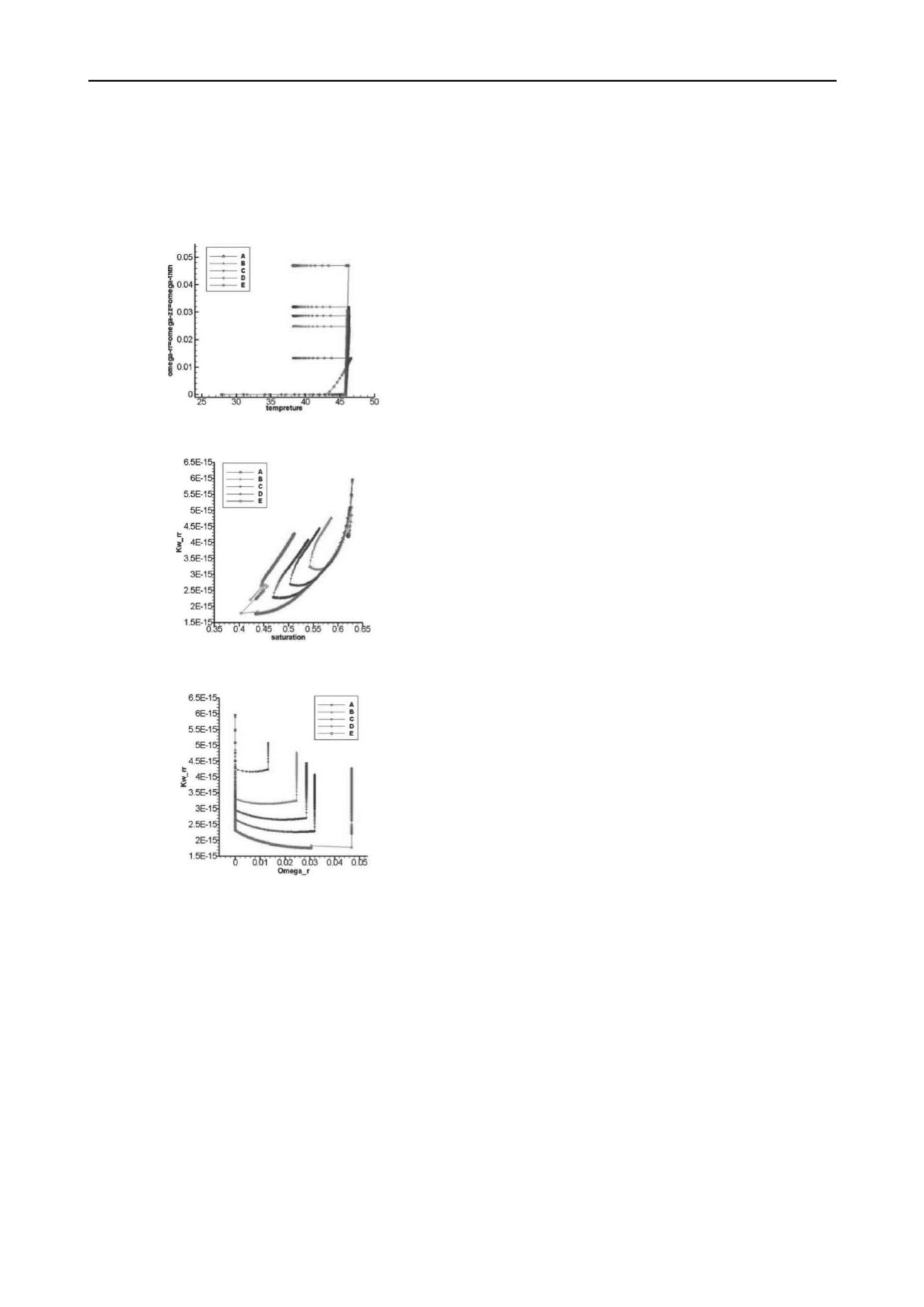
1108
Proceedings of the 18
th
International Conference on Soil Mechanics and Geotechnical Engineering, Paris 2013
sample. It can be clearly seen in Figure 5, that this sample
behaves more brittle in comparison with other samples.
In order to investigate the trend of water permeability, the
variation of this parameter due to saturation degree, and damage
is drawn respectively in Figures 6 and 7, for an element (No.22)
near the heater.
Figure 5. Variation of damage parameter respect to the temperature for
all specimens for element22.
Figure 6. Variation of water permeability respect to the saturation
degree for all specimens for element 22.
Figure 7. Variation of water permeability respect to the damage
parameter for all specimens for element22.
As it shown in Figures 6 and 7 water permeability reduces
from A toward E. This is why the specimens get dry from A to
E. First that there is no crack in samples, and pores are in their
initial size, increasing of saturation degree leads to water
permeability reduction. After occurrence of cracks, pores get
larger. This factor prompts to grow the permeability, but graphs
trend shows that the saturation degree reduction conquers this
factor. Therefore, the coupling of these two parameters causes
falling trend in water permeability. After removing thermal
loading, the magnitude of damage almost remains constant,
while by reversing water direction in samples, saturation degree
rises and therefore permeability increases.
4
CONCLUSIONS
Theoretical framework of a damage model of Arson and
Gatmiri dedicated to non-isothermal unsaturated porous media
and formulated in independent state variables (net stress,
suction and thermal stress) is presented. The damage model has
been implemented in θ-stock Finite Element code. A parametric
study on initial damage is then performed to assess the influence
of the Excavation Damage Zone (EDZ) on the response of the
nuclear waste repository during the heating phase. Different
parameters such as suction and thermal stress effect on
generation of damage. It is observed that water permeability is
mostly affected by the variation of saturation degree of the
specimen. Overall, the trends meet the theoretical expectations.
5
REFERENCES
Arson C. and Gatmiri B. 2010. Numerical study of a
thermohydromechanical damage model for unsaturated porous
media.
Internatinal Journal of Solids and Structural Mechanic
1:59-78.
Arson C. and Gatmiri B. 2008a. On damage modelling in unsaturated
clay rocks.
Phys. Chem. Earth
33 S407-S415.
Cordebois, J., sidoroff, F. (1982). Endommagement anisotrope en
élasticité et plasticité. Journal de Mécanique théorique et
4
ppliqué
pp. 45-60 (1982)
Dragon A. and Halm D. and Desoyer T. 2000. Anisotropic damage in
quasi-brittle solids: modeling, computational issues and
applications.
Comput. Methods appl. Mech. Engrg
. 183, 331-352
Fredlund D. G. and Morgenstern N. R. 1977. Stress state variables for
unsaturated soils.
J Geotech Eng Am Soc Civ Engrs
103(5):447-
466.
Gatmiri B. and Arson C. 2008b. Theta-Stock, a powerfull tool for
themohydromechanical behaviour and damage modeling of
unsaturated porous media.
Computers and Geotechnics
35, 890-
915.
Gatmiri B., Hemmati S., Arson C. and Amirzehni E. 2010. A
multiphase Analysis for enviromental Impact Assessment with θ-
Stock Finite Element Program
. Journal of Multiscale modeling.
Vol
2, Nos 1 & 2, 23-68, Imperial College Press.
Gens A., Garcia-Molina A. J., Olivella S., Alonso E. E., Huertas F.
1998. Analysis of a full scale in situ test simulating repository
conditions.
International Journal for Numerical and Analytical
Methods in Goemechanics
22: 515-548.
Homand-Etienne, Hoxha, Shao. 1998. A continuum damage constitutive
law for brittle rocks,
Computers and Geotechnics
22, 2, 135-151,
(1998).
Houlsby G.T. 1997. The work input to an unsaturated granular material,
Technical Note
. Géotechnique
47(1):193-196.
Martino, J. and Chandler N. 2004. Excavation-induced damage studies
at the underground research laboratory.
Int. J. Rock mech. and Min.
Sci.
41, 1413-1426.
Mertens J., Bastiaens W., Dehandschutter B. 2004. Characterization of
induced discountinuities in the boom clay around the underground
excavations (urf, mol, Belgium).
Appl. Clay Science
26, 413-428.
Pintado X., Ledesma A., Lloret A. 2002. Backanalysis of
thermohydraulic bentonite properties from laboratory tests.
Engineering Geology
64:91–115.
Shao J. F., Zhou H., & Chau K. T. 2005. Coupling between
anisotropic damage and permeability variation in brittle rocks.
International Journal for Numerical and Analytical Methods in
Geomechanics
29: 1231-1247.


